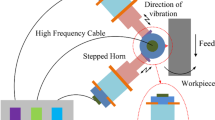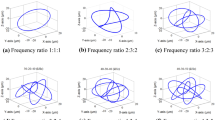Abstract
To explore the formation law and influence factors of three-dimensional geometry in axial turning surface, the turning experiment of 7075 aluminum alloy was carried out by using double excitation three-dimensional ultrasonic elliptical vibration method. Based on the theory of turning kinematics, the tool tip trajectory model of three-dimensional ultrasonic elliptical vibration turning (3D-UEVT) was established, and the related mechanism in surface residual height, surface topography formation characteristics, and turning transmission was given. Through single factor simulation and turning test, the influence of spindle speed, feed speed, amplitude, and phase difference on the surface microstructure and roughness of workpiece was analyzed contrastively. The results show that, compared with the traditional turning, the double excitation ellipse assisted turning can affect the surface topography and quality of the workpiece by causing the dynamic change of the cutting angle of the tool tip and the residual height of the material. Combined with the analysis of simulation and experimental results, it is found that the ideal microstructure and roughness can be obtained with low speed, slow feed, small amplitude, and small phase difference. Meanwhile, the tool workpiece separation characteristics, surface topography, roughness, and surface defect level can be effectively improved under the three-dimensional ultrasonic elliptical assisted vibration.





















Similar content being viewed by others
Data availability
The datasets used or analyzed during the current study are available from the corresponding author on reasonable request.
References
Ulutan D, Ozel T (2011) Machining induced surface integrity intitanium and nickel alloys: a review. Int J Mach Tools Manuf 51(3):250–280
Dimogerontakis T, Vangils S, Ottevaere H, Thienpont HTH (2006) Quantitative topography characterization of surfaces with asymmetric roughness induced by AC-graining on Aluminium. Surf Coat Technol 201(3-4):918–926
Guo YB, Li W, Jawahir IS (2009) Surface integrity characterization and prediction in machining of hardened and difficult-to-machine alloys: a state-of-art research review and analysis. Mach Sci Technol 13:437–470
Cheharon CH, Jawaid A (2005) The effect of machining on surface integrity of titanium alloy Ti–6% Al–4% V. J Mater Process Technol 166:188–192
Ying N, Feng J, Bo Z, Guofu G, Jingjing N (2020) Theoretical investigation of machining-induced residual stresses in longitudinal torsional ultrasonicassisted milling. Int J Adv Manuf Technol 108(11-12):3689–3705
Jianguo Z, Tao C, Cheng G, Yongxin S, Huaijiang Y (2016) Review of micro/nano machining by utilizing elliptical vibration cutting. Int J Mach Tools Manuf 106:109–126
Kurniawan R, Kiswanto G, Jo Ko T (2017) Surface roughness of two-frequency elliptical vibration texturing (TFEVT) method for micro-dimple pattern process. Int J Mach Tools Manuf 116:77–95
Kurniawan R, Ali S, Park KM, Jung ST, Ko TJ (2019) Experimental study of microgroove surface using three-dimensional elliptical vibration texturing. J Micro- Nano- Manuf 7(2):1–7
Nath C, Rahman M, Neo KS (2009) A study on ultrasonic elliptical vibration cutting of tungsten carbide. J Mater Process Technol 209:4459–4464
Silberschmidt VV, Mahdy SMA, Gouda MA, Naseer A, Maurotto A, Roy A (2014) Surface-roughness improvement in ultrasonically assisted turning. Procedia CIRP 13:49–54
Nath C, Rahman M, Andrew SSK (2007) A study on ultrasonic vibration cutting of low alloy steel. J Mater Process Technol 192-193(4):159–165
Chen Z, Yun S (2019) Design and kinematic analysis of a novel decoupled 3D ultrasonic elliptical vibration assisted cutting mechanism. Ultrasonics 95:79–94
Chen Z, Yun S (2019) A novel design method for 3D elliptical vibration-assisted cutting mechanism. Mech Mach Theory 134:308–322
Yang Y, Yayue P, Ping G (2017) Structural coloration of metallic surfaces with micro/nano-structures induced by elliptical vibration texturing. Appl Surf Sci 402:400–409
Zhichao Y, Lida Z, Guixiang Z, Chenbing N, Bin L (2020) Review of ultrasonic vibration assisted machining in advanced materials. Int J Mach Tools Manuf 156:103594
Xiaoming L, Binliang H, Zhijin Z (2014) Research on unidirectional ultrasonic vibrations turning7075-T6 aluminum alloy surface quality and morphology. J Hunan Univ Sci Technol (Nat Sci Ed) 29(2):28–30 (in Chinese)
Jinglin T, Junshuai Z, Peng C, Bo Z (2020) Effect of ultrasonic elliptical vibration turning on the microscopic morphology of aluminum alloy surface. Int J Adv Manuf Technol 106:1397–1407
Weihai H, Deping Y, Xinquan Z, Min Z, Dongsheng C (2018) Ductile-regime machining model for ultrasonic elliptical vibration cutting of brittle materials. J Manuf Process 36:68–76
Mingming L, Hao W, Liang G, Jieqiong L, Yan G, Bin C, Dongpo Z (2018) Modeling and analysis of surface topography of Ti6Al4V alloy machining by elliptical vibration cutting. Int J Adv Manuf Technol 98(9-12):2759–2768
Chen Z, Guilin S, Kornel FE (2017) Investigation of hybrid micro-texture fabrication in elliptical vibration-assisted cutting. Int J Mach Tools Manuf 120:72–84
Chao K, Dazhong W (2018) Numerical investigation of the performance of elliptical vibration cutting in machining of AISI 1045 steel. Int J Adv Manuf Technol 98:715–727
Teng C, Dong L, Rong S, Guowen P, Yongbo W (2018) Simulation on surface micro texture of aluminium alloy based on ultrasonic elliptical vibration cutting. J Shaanxi Normal Univ (Nat Sci Ed) 46(4):50–57 (in Chinese)
Lusheng Y, Bo Z, Yi W, Chongyang Z (2019) Study on surface micro-texture characteristics of 7075 aluminum alloy by elliptical vibration assisted cutting. Chin Mech Eng. http://kns.cnki.net/kcms/detail/42.1294.th.20191113.1450.029.html (in Chinese)
Xinquan Z, Senthil Kumar A, Rahman M, Nath C, Kui L (2011) Experimental study on ultrasonic elliptical vibration cutting of hardened steel using PCD tools. J Mater Process Technol 211(11):1701–1709
Wule Z, Yu H, Kornel FE, Zhiwei Z, Bingfeng J (2017) Modeling of the effects of phase shift on cutting performance in elliptical vibration cutting. Int J Adv Manuf Technol 92:3103–3115
Yu'an J, Jun P, Guang Y, Tao J, Zhihuang S (2019) Influence of ultrasonic elliptical vibration cutting trajectory change on surface morphology. Acta Armamentarii 40(10):2170–2176
Cunying Z, Bo Z, Xiaobo W (2019) Modeling and experiment of surface microstructure by longitudinal-torsional compound ultrasonic end milling. Surf Technol 48(10):52–63 (in Chinese)
Funding
This research was supported by the National Natural Science Foundation of China through Grant No. U1604255 and Natural Science Foundation of Henan No.202300410172.
Author information
Authors and Affiliations
Contributions
Bingjun Huo: methodology, MATLAB simulation, and writing original draft. Bo Zhao: funding acquisition, methodology, and writing–review and editing. Long Yin: methodology and experimental research. Xingcheng Guo: review and MATLAB simulation. Xiaobo Wang: investigation and review.
Corresponding author
Ethics declarations
Ethics approval and consent to participate
The authors state that this paper is an original work, it has not been published in any journals, and this research does not involve any ethical issues of humans or animals. The authors declare that this research involves no Human Participants and/or Animals.
Consent for publication
The authors confirm the paper described has not been published before; that it is not under consideration for publication elsewhere; that its publication has been approved by all co-authors; that its publication has been approved by the responsible authorities at the institution where the work is carried out. The authors agree to publication in the Journal indicated below and also to publication of the article in English by Springer in springer’s corresponding English-language journal. The copyright to the English-language article is transferred to Springer effective if and when the article is accepted for publication. The author warrants that his/her contribution is original and that he/she has full power to make this grant. The author signs for and accepts responsibility for releasing this material on behalf of any and all co-authors. The copyright transfer covers the exclusive right to reproduce and distribute the article, including reprints, translations, photographic reproductions, microform, electronic form (offline, online), or any other reproductions of similar nature.
Competing interests
The authors declare no competing interests.
Additional information
Publisher’s note
Springer Nature remains neutral with regard to jurisdictional claims in published maps and institutional affiliations.
Rights and permissions
About this article
Cite this article
Huo, B., Zhao, B., Yin, L. et al. Effect of double-excitation ultrasonic elliptical vibration turning trajectory on surface morphology. Int J Adv Manuf Technol 113, 1401–1414 (2021). https://doi.org/10.1007/s00170-021-06684-5
Received:
Accepted:
Published:
Issue Date:
DOI: https://doi.org/10.1007/s00170-021-06684-5




